History of water supply and sanitation
The history of water supply and sanitation is one of a logistical challenge to provide clean water and sanitation systems since the dawn of civilization. Where water resources, infrastructure or sanitation systems were insufficient, diseases spread and people fell sick or died prematurely.

Major human settlements could initially develop only where fresh surface water was plentiful, such as near rivers or natural springs. Throughout history, people have devised systems to make getting water into their communities and households and disposing of (and later also treating) wastewater more convenient.[1]
The historical focus of sewage treatment was on the conveyance of raw sewage to a natural body of water, e.g. a river or ocean, where it would be diluted and dissipated. Early human habitations were often built next to water sources. Rivers would often serve as a crude form of natural sewage disposal.
Over the millennia, technology has dramatically increased the distances across which water can be relocated. Furthermore, treatment processes to purify drinking water and to treat wastewater have been improved.
Prehistory
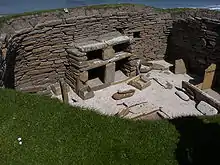
During the Neolithic era, humans dug the first permanent water wells, from where vessels could be filled and carried by hand. Wells dug around 6500 BC have been found in the Jezreel Valley.[2] The size of human settlements was largely dependent on nearby available water.
A primitive indoor, tree bark lined, two-channel, stone, fresh and wastewater system appears to have featured in the houses of Skara Brae, and the Barnhouse Settlement, from around 3000 BCE, along with a cell-like enclave in a number of houses, of Skara Brae, that it has been suggested may have functioned as an early indoor Latrine.[3][4][5][6][7]
Wastewater reuse activities
Wastewater reuse is an ancient practice, which has been applied since the dawn of human history, and is connected to the development of sanitation provision.[8] Reuse of untreated municipal wastewater has been practiced for many centuries with the objective of diverting human waste outside of urban settlements. Likewise, land application of domestic wastewater is an old and common practice, which has gone through different stages of development.
Domestic wastewater was used for irrigation by prehistoric civilizations (e.g. Mesopotamian, Indus valley, and Minoan) since the Bronze Age (ca. 3200-1100 BC).[9] Thereafter, wastewater was used for disposal, irrigation, and fertilization purposes by Hellenic civilizations and later by Romans in areas surrounding cities (e.g. Athens and Rome).[10] Moreover, in China, use of human excreta for fertilizing agricultural crops has been practised since ancient time.[11][12]
Bronze and early Iron Ages
Mesopotamia
The Mesopotamians introduced the world to clay sewer pipes around 4000 BCE, with the earliest examples found in the Temple of Bel at Nippur and at Eshnunna,[13] utilised to remove wastewater from sites, and capture rainwater, in wells. The city of Uruk also demonstrates the first examples of brick constructed Latrines, from 3200 BCE.[14][15] Clay pipes were later used in the Hittite city of Hattusa.[16] They had easily detachable and replaceable segments, and allowed for cleaning.
Ancient Persia
The first sanitation systems within prehistoric Iran were built near the city of Zabol.[13] Persian Qanats and ab anbars have been used for water supply and cooling.
Ancient Egypt
The c.2400 BCE, Pyramid of Sahure, and adjoining temple complex at Abusir, was discovered to have a network of copper drainage pipes.[17]
Ancient China
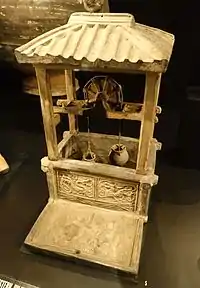
Some of the earliest evidence of water wells are located in China. The Neolithic Chinese discovered and made extensive use of deep drilled groundwater for drinking. The Chinese text The Book of Changes, originally a divination text of the Western Zhou dynasty (1046 -771 BC), contains an entry describing how the ancient Chinese maintained their wells and protected their sources of water.[18] Archaeological evidence and old Chinese documents reveal that the prehistoric and ancient Chinese had the aptitude and skills for digging deep water wells for drinking water as early as 6000 to 7000 years ago. A well excavated at the Hemedu excavation site was believed to have been built during the Neolithic era.[19] The well was caused by four rows of logs with a square frame attached to them at the top of the well. Sixty additional tile wells southwest of Beijing are also believed to have been built around 600 BC for drinking and irrigation.[19][20] Plumbing is also known to have been used in East Asia since the Qin and Han Dynasties of China.[21]
Indus Valley Civilization

The Indus Valley Civilization in Asia shows early evidence of public water supply and sanitation. The system the Indus developed and managed included a number of advanced features. A typical example is the Indus city of Lothal (c. 2350 BCE). In Lothal all houses had their own private toilet which was connected to a covered sewer network constructed of brickwork held together with a gypsum-based mortar that emptied either into the surrounding water bodies or alternatively into cesspits, the latter of which were regularly emptied and cleaned.[22] Also, the Maya had plumbing with pressurized water.[23]
The urban areas of the Indus Valley civilization included public and private baths. Sewage was disposed through underground drains built with precisely laid bricks, and a sophisticated water management system with numerous reservoirs was established. In the drainage systems, drains from houses were connected to wider public drains. Many of the buildings at Mohenjo-daro had two or more stories. Water from the roof and upper storey bathrooms was carried through enclosed terracotta pipes or open chutes that emptied out onto the street drains.[24]
The earliest evidence of urban sanitation was seen in Harappa, Mohenjo-daro, and the recently discovered Rakhigarhi of Indus Valley civilization. This urban plan included the world's first urban sanitation systems. Within the city, individual homes or groups of homes obtained water from wells. From a room that appears to have been set aside for bathing, waste water was directed to covered drains, which lined the major streets.
Devices such as shadoofs were used to lift water to ground level. Ruins from the Indus Valley Civilization like Mohenjo-daro in Pakistan and Dholavira in Gujarat in India had settlements with some of the ancient world's most sophisticated sewage systems. They included drainage channels, rainwater harvesting, and street ducts.
Stepwells have mainly been used in the Indian subcontinent.
Ancient Greece
The ancient Greek civilization of Crete, known as the Minoan civilization, was the first civilization to use underground clay pipes for sanitation and water supply.[25] Their capital, Knossos, had a well-organized water system for bringing in clean water, taking out waste water and storm sewage canals for overflow when there was heavy rain. It was also one of the first uses of a flush toilet, dating back to the 18th century BC.[26] The Minoan civilization had stone sewers that were periodically flushed with clean water. In addition to sophisticated water and sewer systems they devised elaborate heating systems. The Ancient Greeks of Athens and Asia Minor also used an indoor plumbing system, used for pressurized showers.[27] The Greek inventor Heron used pressurized piping for fire fighting purposes in the City of Alexandria.[28] The Mayans were the third earliest civilization to have employed a system of indoor plumbing using pressurized water.[29]
An inverted siphon system, along with glass covered clay pipes, was used for the first time in the palaces of Crete, Greece. It is still in working condition, after about 3000 years.
Roman Empire

In ancient Rome, the Cloaca Maxima, considered a marvel of engineering, disgorged into the Tiber.
Public latrines were built over the Cloaca Maxima.[30]
The Roman Empire had indoor plumbing, meaning a system of aqueducts and pipes that terminated in homes and at public wells and fountains for people to use. Rome and other nations used lead pipes; while commonly thought to be the cause of lead poisoning in the Roman Empire, the combination of running water which did not stay in contact with the pipe for long and the deposition of precipitation scale actually mitigated the risk from lead pipes.[31][32]
Roman towns and garrisons in the United Kingdom between 46 BC and 400 AD had complex sewer networks sometimes constructed out of hollowed-out elm logs, which were shaped so that they butted together with the down-stream pipe providing a socket for the upstream pipe.
Medieval and early modern ages
Nepal
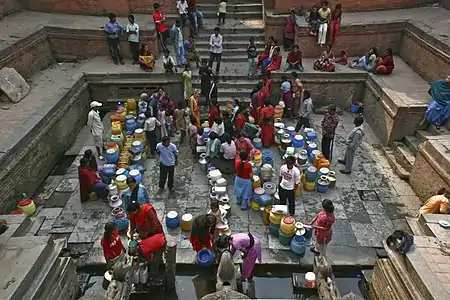
In Nepal a drinking water supply system was developed starting at least as early as 550 AD.[33] This dhunge dhara or hiti system consists of carved stone fountains through which water flows uninterrupted from underground sources. These are supported by numerous ponds and canals that form an elaborate network of water bodies, created as a water resource during the dry season and to help alleviate the water pressure caused by the monsoon rains. After the introduction of modern, piped water systems, starting in the late 19th century, this old system has fallen into disrepair and some parts of it are lost forever. Nevertheless, many people of Nepal still rely on the old hitis on a daily basis.
In 2008 the dhunge dharas of the Kathmandu Valley produced 2.95 million litres of water per day.[34]
Of the 389 stone spouts found in the Kathmandu Valley in 2010, 233 were still in use, serving about 10% of Kathmandu’s population. 68 had gone dry, 45 were lost entirely and 43 were connected to the municipal water supply instead of their original source.[35]
Islamic world
Islam stresses the importance of cleanliness and personal hygiene.[36] Islamic hygienical jurisprudence, which dates back to the 7th century, has a number of elaborate rules. Taharah (ritual purity) involves performing wudu (ablution) for the five daily salah (prayers), as well as regularly performing ghusl (bathing), which led to bathhouses being built across the Islamic world.[37][38] Islamic toilet hygiene also requires washing with water after using the toilet, for purity and to minimize germs.[39]
In the Abbasid Caliphate (8th-13th centuries), its capital city of Baghdad (Iraq) had 65,000 baths, along with a sewer system.[40] Cities of the medieval Islamic world had water supply systems powered by hydraulic technology that supplied drinking water along with much greater quantities of water for ritual washing, mainly in mosques and hammams (baths). Bathing establishments in various cities were rated by Arabic writers in travel guides. Medieval Islamic cities such as Baghdad, Córdoba (Islamic Spain), Fez (Morocco) and Fustat (Egypt) also had sophisticated waste disposal and sewage systems with interconnected networks of sewers. The city of Fustat also had multi-storey tenement buildings (with up to six floors) with flush toilets, which were connected to a water supply system, and flues on each floor carrying waste to underground channels.[41]
Al-Karaji (c. 953–1029) wrote a book, The Extraction of Hidden Waters, which presented ground-breaking ideas and descriptions of hydrological and hydrogeological perceptions such as components of the hydrological cycle, groundwater quality, and driving factors of groundwater flow. He also gave an early description of a water filtration process.[42]
Post-classical East Africa
In post-classical Kilwa plumbing was prevalent in the stone homes of the natives.[43][44] The Husani Kubwa Palace as well as other buildings for the ruling elite and wealthy included the luxury of indoor plumbing.[44]
Medieval Europe


There is little record of other sanitation systems (apart of sanitation in ancient Rome) in most of Europe until the High Middle Ages. Unsanitary conditions and overcrowding were widespread throughout Europe and Asia during the Middle Ages. This resulted in pandemics such as the Plague of Justinian (541–542) and the Black Death (1347–1351), which killed tens of millions of people.[45] Very high infant and child mortality prevailed in Europe throughout medieval times, due partly to deficiencies in sanitation.[46]
In medieval European cities, small natural waterways used for carrying off wastewater were eventually covered over and functioned as sewers. London's River Fleet is such a system. Open drains, or gutters, for waste water run-off ran along the center of some streets. These were known as "kennels" (i.e., canals, channels), and in Paris were sometimes known as “split streets,” as the waste water running along the middle physically split the streets into two halves. The first closed sewer constructed in Paris was designed by Hugues Aubird in 1370 on Rue Montmartre (Montmartre Street), and was 300 meters long. The original purpose of designing and constructing a closed sewer in Paris was less-so for waste management as much as it was to hold back the stench coming from the odorous waste water.[47] In Dubrovnik, then known as Ragusa (Latin name), the Statute of 1272 set out the parameters for the construction of septic tanks and channels for the removal of dirty water. Throughout the 14th and 15th century the sewage system was built, and it is still operational today, with minor changes and repairs done in recent centuries.[48] Pail closets, outhouses, and cesspits were used to collect human waste. The use of human waste as fertilizer was especially important in China and Japan, where cattle manure was less available. However, most cities did not have a functioning sewer system before the Industrial era , relying instead on nearby rivers or occasional rain showers to wash away the sewage from the streets . In some places, waste water simply ran down the streets, which had stepping stones to keep pedestrians out of the muck, and eventually drained as runoff into the local watershed.
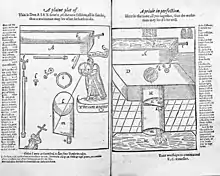
In the 16th century, Sir John Harington invented a flush toilet as a device for Queen Elizabeth I (his godmother) that released wastes into cesspools.[49]
After the adoption of gunpowder, municipal outhouses became an important source of raw material for the making of saltpeter in European countries.[50]
In London, the contents of the city's outhouses were collected every night by commissioned wagons and delivered to the nitrite beds where it was laid into specially designed soil beds to produce earth rich in mineral nitrates. The nitrate rich-earth would be then further processed to produce saltpeter, or potassium nitrate, an important ingredient in black powder that played a part in the making of gunpowder.[51]
Classic and early modern Mesoamerica
The Classic Maya at Palenque had underground aqueducts and flush toilets; the Classic Maya even used household water filters using locally abundant limestone carved into a porous cylinder, made so as to work in a manner strikingly similar to Modern ceramic water filters.[52][53]
Sewage farms for disposal and irrigation
“Sewage farms” (i.e. wastewater application to the land for disposal and agricultural use) were operated in Bunzlau (Silesia) in 1531, in Edinburgh (Scotland) in 1650, in Paris (France) in 1868, in Berlin (Germany) in 1876 and in different parts of the USA since 1871, where wastewater was used for beneficial crop production.[54][55] In the following centuries (16th and 18th centuries) in many rapidly growing countries/cities of Europe (e.g. Germany, France) and the United States, “sewage farms” were increasingly seen as a solution for the disposal of large volumes of the wastewater, some of which are still in operation today.[56] Irrigation with sewage and other wastewater effluents has a long history also in China and India;[57] while also a large “sewage farm” was established in Melbourne, Australia, in 1897.[58]
Modern age
Sewer systems
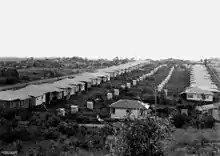
A significant development was the construction of a network of sewers to collect wastewater. In some cities, including Rome, Istanbul (Constantinople) and Fustat, networked ancient sewer systems continue to function today as collection systems for those cities' modernized sewer systems. Instead of flowing to a river or the sea, the pipes have been re-routed to modern sewer treatment facilities.
However, until the Enlightenment era, little progress was made in water supply and sanitation and the engineering skills of the Romans were largely neglected throughout Europe. This began to change in the 17th and 18th centuries with a rapid expansion in waterworks and pumping systems.
The tremendous growth of cities during the Industrial Revolution quickly led to terribly overpolluted streets, which acted as a constant source for the outbreak of disease.[59]
People wealthy enough to enjoy 19th century flush toilets often had the political power to allow them to drain into public sewers; and the practice became the norm as indoor plumbing became more common, based on large-scale supply networks such as the Croton Aqueduct in New York.
As cities grew in the 19th century concerns were raised about public health.[60]:33–62 As part of a trend of municipal sanitation programs in the late 19th and 20th centuries, many cities constructed extensive sewer systems to help control outbreaks of disease such as typhoid and cholera.[61]:29–34
Initially these systems discharged sewage directly to surface waters without treatment.[62] Later, cities attempted to treat the sewage before discharge in order to prevent water pollution and waterborne diseases. During the half-century around 1900, these public health interventions succeeded in drastically reducing the incidence of water-borne diseases among the urban population, and were an important cause in the increases of life expectancy experienced at the time.[63]
Early techniques involved land application of sewage on agricultural land.[62] The use of the land treatment systems continued into the nineteenth/twentieth century in central Europe, USA, and other locations all over the world, but not without causing serious public health concerns and negative environmental impacts. During the 1840s and 1850s, this practice resulted in disastrous spread of waterborne diseases like cholera and typhoid.[64] However, when the water supply links with these diseases became clear, engineering solutions were implemented that include the development of alternative water sources using reservoirs and aqueduct systems, relocation of water intakes, and water and wastewater treatment systems.[65]
In the late 19th century some cities began to add chemical treatment and sedimentation systems to their sewers.[66]:28 Most cities in the Western world added more expensive systems for sewage treatment in the 20th century, after scientists at the University of Manchester discovered the sewage treatment process of activated sludge in 1912.[67]
Storm and sanitary sewers were necessarily developed along with the growth of cities. By the 1840s the luxury of indoor plumbing, which mixes human waste with water and flushes it away, eliminated the need for cesspools. The odor was considered the big problem in waste disposal and to address it, sewage could be drained to a lagoon, or "settled" and the solids removed, to be disposed of separately. This process is now called "primary treatment" and the settled solids are called "sludge."
Liverpool, London and other cities, UK
As recently as the late 19th-century sewerage systems in some parts of the rapidly industrializing United Kingdom were so inadequate that water-borne diseases such as cholera and typhoid remained a risk.
From as early as 1535 there were efforts to stop polluting the River Thames in London. Beginning with an Act passed that year that was to prohibit the dumping of excrement into the river. Leading up to the Industrial Revolution the River Thames was identified as being thick and black due to sewage, and it was even said that the river “smells like death.”[68] As Britain was the first country to industrialize, it was also the first to experience the disastrous consequences of major urbanisation and was the first to construct a modern sewerage system to mitigate the resultant unsanitary conditions. During the early 19th century, the River Thames was effectively an open sewer, leading to frequent outbreaks of cholera epidemics. Proposals to modernize the sewerage system had been made during 1856 but were neglected due to lack of funds. However, after the Great Stink of 1858, Parliament realized the urgency of the problem and resolved to create a modern sewerage system.[69]
However, ten years earlier and 200 miles to the north, James Newlands, a Scottish Engineer, was one of a celebrated trio of pioneering officers appointed under a private Act, the Liverpool Sanitory Act by the Borough of Liverpool Health of Towns Committee. The other officers appointed under the Act were William Henry Duncan, Medical Officer for Health, and Thomas Fresh, Inspector of Nuisances (an early antecedent of the environmental health officer). One of five applicants for the post, Newlands was appointed Borough Engineer of Liverpool on 26 January 1847.
He made a careful and exact survey of Liverpool and its surroundings, involving approximately 3,000 geodetical observations, and resulting in the construction of a contour map of the town and its neighbourhood, on a scale of one inch to 20 feet (6.1 m). From this elaborate survey Newlands proceeded to lay down a comprehensive system of outlet and contributory sewers, and main and subsidiary drains, to an aggregate extent of nearly 300 miles (480 km). The details of this projected system he presented to the Corporation in April 1848.
In July 1848 James Newlands' sewer construction programme began, and over the next 11 years 86 miles (138 km) of new sewers were built. Between 1856 and 1862 another 58 miles (93 km) were added. This programme was completed in 1869. Before the sewers were built, life expectancy in Liverpool was 19 years, and by the time Newlands retired it had more than doubled.
Joseph Bazalgette, a civil engineer and Chief Engineer of the Metropolitan Board of Works, was given responsibility for the work. He designed an extensive underground sewerage system that diverted waste to the Thames Estuary, downstream of the main center of population. Six main interceptor sewers, totaling almost 100 miles (160 km) in length, were constructed, some incorporating stretches of London's 'lost' rivers. Three of these sewers were north of the river, the southernmost, low-level one being incorporated in the Thames Embankment. The Embankment also allowed new roads, new public gardens, and the Circle Line of the London Underground.
The intercepting sewers, constructed between 1859 and 1865, were fed by 450 miles (720 km) of main sewers that, in turn, conveyed the contents of some 13,000 miles (21,000 km) of smaller local sewers. Construction of the interceptor system required 318 million bricks, 2.7 million cubic metres of excavated earth and 670,000 cubic metres of concrete.[70] Gravity allowed the sewage to flow eastwards, but in places such as Chelsea, Deptford and Abbey Mills, pumping stations were built to raise the water and provide sufficient flow. Sewers north of the Thames feed into the Northern Outfall Sewer, which fed into a major treatment works at Beckton. South of the river, the Southern Outfall Sewer extended to a similar facility at Crossness. With only minor modifications, Bazalgette's engineering achievement remains the basis for sewerage design up into the present day.[71]
In Merthyr Tydfil, a large town in South Wales, most houses discharged their sewage to individual cess-pits which persistently overflowed causing the pavements to be awash with foul sewage.[72]
Paris, France
In 1802 Napoleon built the Ourcq canal which brought 70,000 cubic meters of water a day to Paris, while the Seine river received up to 100,000 cubic meters of wastewater per day. The Paris cholera epidemic of 1832 sharpened the public awareness of the necessity for some sort of drainage system to deal with sewage and wastewater in a better and healthier way. Between 1865 and 1920 Eugene Belgrand lead the development of a large scale system for water supply and wastewater management. Between these years approximately 600 kilometers of aqueducts were built to bring in potable spring water, which freed the poor quality water to be used for flushing streets and sewers. By 1894 laws were passed which made drainage mandatory. The treatment of Paris sewage, though, was left to natural devices as 5,000 hectares of land were used to spread the waste out to be naturally purified. Further, the lack of sewage treatment left Parisian sewage pollution to become concentrated downstream in the town of Clichy, effectively forcing residents to pack up and move elsewhere.[47]
The 19th century brick-vaulted Paris sewers serve as a tourist attraction nowadays.
Hamburg and Frankfurt, Germany
The first comprehensive sewer system in a German city was built in Hamburg, Germany, in the mid-19th century.[66]:2[73]:43[74]
In 1863, work began on the construction of a modern sewerage system for the rapidly growing city of Frankfurt am Main, based on design work by William Lindley. 20 years after the system's completion, the death rate from typhoid had fallen from 80 to 10 per 100,000 inhabitants.[66][73]:43[75]

United States
The first sewer systems in the United States were built in the late 1850s in Chicago and Brooklyn.[73]:43
In the United States, the first sewage treatment plant using chemical precipitation was built in Worcester, Massachusetts, in 1890.[66]:29
Sewage treatment plants
At the end of the 19th century, since primary treatment still left odor problems, it was discovered that bad odors could be prevented by introducing oxygen into the decomposing sewage. This was the beginning of the biological aerobic and anaerobic treatments which are fundamental to wastewater processes.
As pollution of water bodies became a concern, cities attempted to treat the sewage before discharge.[76] In the late 19th century some cities began to add chemical treatment and sedimentation systems to their sewers.[66]:28 In the United States, the first sewage treatment plant using chemical precipitation was built in Worcester, Massachusetts in 1890.[66]:29 Most cities in the Western world added more expensive systems for sewage treatment in the early 20th century, after scientists at the University of Manchester discovered the sewage treatment process of activated sludge in 1912.[67] During the half-century around 1900, these public health interventions succeeded in drastically reducing the incidence of water-borne diseases among the urban population, and were an important cause in the increases of life expectancy experienced at the time.[63]
Toilets
With the onset of the industrial revolution and related advances in technology, the flush toilet began to emerge into its modern form. It needs to be connected to a sewer system though. Where this is not feasible or desired, dry toilets are an alternative option.
Water supply
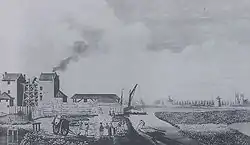
An ambitious engineering project to bring fresh water from Hertfordshire to London was undertaken by Hugh Myddleton, who oversaw the construction of the New River between 1609 and 1613. The New River Company became one of the largest private water companies of the time, supplying the City of London and other central areas.[77]
It was in the 18th century that a rapidly growing population fueled a boom in the establishment of private water supply networks in London. The Chelsea Waterworks Company was established in 1723 "for the better supplying the City and Liberties of Westminster and parts adjacent with water".[78][79] The company created extensive ponds in the area bordering Chelsea and Pimlico using water from the tidal Thames. Other waterworks were established in London, including at West Ham in 1743, at Lea Bridge before 1767, Lambeth Waterworks Company in 1785, West Middlesex Waterworks Company in 1806[80] and Grand Junction Waterworks Company in 1811.[81]
The S-bend pipe was invented by Alexander Cummings in 1775 but became known as the U-bend following the introduction of the U-shaped trap by Thomas Crapper in 1880. The first screw-down water tap was patented in 1845 by Guest and Chrimes, a brass foundry in Rotherham.[82]
Sand filter
Sir Francis Bacon attempted to desalinate sea water by passing the flow through a sand filter. Although his experiment did not succeed, it marked the beginning of a new interest in the field.
The first documented use of sand filters to purify the water supply dates to 1804, when the owner of a bleachery in Paisley, Scotland, John Gibb, installed an experimental filter, selling his unwanted surplus to the public.[83][84] This method was refined in the following two decades by engineers working for private water companies, and it culminated in the first treated public water supply in the world, installed by engineer James Simpson for the Chelsea Waterworks Company in London in 1829.[85][86] This installation provided filtered water for every resident of the area, and the network design was widely copied throughout the United Kingdom in the ensuing decades.
The Metropolis Water Act introduced the regulation of the water supply companies in London, including minimum standards of water quality for the first time. The Act "made provision for securing the supply to the Metropolis of pure and wholesome water", and required that all water be "effectually filtered" from 31 December 1855.[87] This was followed up with legislation for the mandatory inspection of water quality, including comprehensive chemical analyses, in 1858. This legislation set a worldwide precedent for similar state public health interventions across Europe. The Metropolitan Commission of Sewers was formed at the same time, water filtration was adopted throughout the country, and new water intakes on the Thames were established above Teddington Lock. Automatic pressure filters, where the water is forced under pressure through the filtration system, were innovated in 1899 in England.[83]
Water chlorination
In what may have been one of the first attempts to use chlorine, William Soper used chlorinated lime to treat the sewage produced by typhoid patients in 1879.
In a paper published in 1894, Moritz Traube formally proposed the addition of chloride of lime (calcium hypochlorite) to water to render it "germ-free." Two other investigators confirmed Traube's findings and published their papers in 1895.[88] Early attempts at implementing water chlorination at a water treatment plant were made in 1893 in Hamburg, Germany, and in 1897 the city of Maidstone, England, was the first to have its entire water supply treated with chlorine.[89]
Permanent water chlorination began in 1905, when a faulty slow sand filter and a contaminated water supply led to a serious typhoid fever epidemic in Lincoln, England.[90] Dr. Alexander Cruickshank Houston used chlorination of the water to stem the epidemic. His installation fed a concentrated solution of chloride of lime to the water being treated. The chlorination of the water supply helped stop the epidemic and as a precaution, the chlorination was continued until 1911 when a new water supply was instituted.[91]

The first continuous use of chlorine in the United States for disinfection took place in 1908 at Boonton Reservoir (on the Rockaway River), which served as the supply for Jersey City, New Jersey.[92] Chlorination was achieved by controlled additions of dilute solutions of chloride of lime (calcium hypochlorite) at doses of 0.2 to 0.35 ppm. The treatment process was conceived by Dr. John L. Leal and the chlorination plant was designed by George Warren Fuller.[93] Over the next few years, chlorine disinfection using chloride of lime were rapidly installed in drinking water systems around the world.[94]
The technique of purification of drinking water by use of compressed liquefied chlorine gas was developed by a British officer in the Indian Medical Service, Vincent B. Nesfield, in 1903. According to his own account, "It occurred to me that chlorine gas might be found satisfactory ... if suitable means could be found for using it.... The next important question was how to render the gas portable. This might be accomplished in two ways: By liquefying it, and storing it in lead-lined iron vessels, having a jet with a very fine capillary canal, and fitted with a tap or a screw cap. The tap is turned on, and the cylinder placed in the amount of water required. The chlorine bubbles out, and in ten to fifteen minutes the water is absolutely safe. This method would be of use on a large scale, as for service water carts."[95]
U.S. Army Major Carl Rogers Darnall, Professor of Chemistry at the Army Medical School, gave the first practical demonstration of this in 1910. Shortly thereafter, Major William J. L. Lyster of the Army Medical Department used a solution of calcium hypochlorite in a linen bag to treat water. For many decades, Lyster's method remained the standard for U.S. ground forces in the field and in camps, implemented in the form of the familiar Lyster Bag (also spelled Lister Bag). This work became the basis for present day systems of municipal water purification.
Fluoridation
Water fluoridation is a practice that has been carried out since the early 20th century for the purpose of decreasing tooth decay.
Trends
The Sustainable Development Goal 6 formulated in 2015 includes targets on access to water supply and sanitation at a global level. In developing countries, self-supply of water and sanitation is used as an approach of incremental improvements to water and sanitation services, which are mainly financed by the user. Decentralized wastewater systems are also growing in importance to achieve sustainable sanitation.[96]
Understanding of health aspects
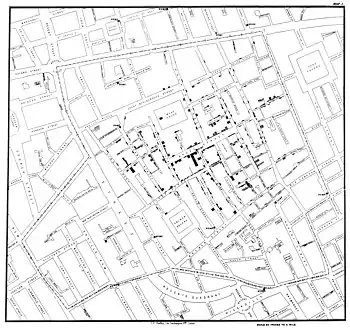
A basic form of contagion theory dates back to medicine in the medieval Islamic world, where it was proposed by Persian physician Ibn Sina (also known as Avicenna) in The Canon of Medicine (1025), the most authoritative medical textbook of the Middle Ages. He mentioned that people can transmit disease to others by breath, noted contagion with tuberculosis, and discussed the transmission of disease through water and dirt.[97] The concept of invisible contagion was eventually widely accepted by Islamic scholars. In the Ayyubid Sultanate, they referred to them as najasat ("impure substances"). The fiqh scholar Ibn al-Haj al-Abdari (c. 1250–1336), while discussing Islamic diet and hygiene, gave advice and warnings about how contagion can contaminate water, food, and garments, and could spread through the water supply.[98]
Long before studies had established the germ theory of disease, or any advanced understanding of the nature of water as a vehicle for transmitting disease, traditional beliefs had cautioned against the consumption of water, rather favoring processed beverages such as beer, wine and tea. For example, in the camel caravans that crossed Central Asia along the Silk Road, the explorer Owen Lattimore noted, "The reason we drank so much tea was because of the bad water. Water alone, unboiled, is never drunk. There is a superstition that it causes blisters on the feet."[99]
Founders of microscopy, Antonie van Leeuwenhoek and Robert Hooke, used the newly invented microscope to observe for the first time small material particles that were suspended in the water, laying the groundwork for the future understanding of waterborne pathogens and waterborne diseases.[100]
In the 19th century, Britain was the center for rapid urbanization, and as a result, many health and sanitation problems manifested, for example cholera outbreaks and pandemics. This resulted in Britain playing a large role in the development for public health.[101] Before discovering the link between contaminated drinking water and diseases, such as cholera and other waterborne diseases, the miasma theory was used to justify the outbreaks of these illnesses.[101] Miasma theory is the theory that certain diseases and illnesses are the products of "bad airs".[102] The investigations of the physician John Snow in the United Kingdom during the 1854 Broad Street cholera outbreak clarified the connections between waterborne diseases and polluted drinking water. Although the germ theory of disease had not yet been developed, Snow's observations led him to discount the prevailing miasma theory. His 1855 essay On the Mode of Communication of Cholera conclusively demonstrated the role of the water supply in spreading the cholera epidemic in Soho,[103] with the use of a dot distribution map and statistical proof to illustrate the connection between the quality of the water source and cholera cases. During the 1854 epidemic, he collected and analyzed data establishing that people who drank water from contaminated sources such as the Broad Street pump died of cholera at much higher rates than those who got water elsewhere. His data convinced the local council to disable the water pump, which promptly ended the outbreak.
Edwin Chadwick, in particular, played a key role in Britain's sanitation movement, using the miasma theory to back up his plans for improving the sanitation situation in Britain.[101] Although Chadwick brought contributions to developing public health in the 19th century, it was John Snow and William Budd who introduced the idea that cholera was the consequence of contaminated water, presenting the idea that diseases could be transmitted through drinking water.[101]
People found that purifying and filtering their water improved the water quality and limited the cases of waterborne diseases.[101] In the German town Altona this finding was first illustrated by using a sand filtering system for its water supply.[101] A nearby town that didn't use any filtering system for their water suffered from the outbreak while Altona remained unaffected by the disease, providing evidence that the quality of water had something to do with the diseases.[101] After this discovery, Britain and the rest of Europe took into account to filter their drinking water, as well as chlorinating them to fight off waterborne diseases like cholera.[101]
See also
References
- "The Art of Plumbing as Recorded through History". www.academia.edu. Retrieved 10 March 2016.
- Ashkenazi, Eli (9 November 2012). "Ancient well reveals secrets of first Jezreel Valley farmers". haaretz.com. Haaretz. Retrieved 26 March 2014.
- Childe, V.; Paterson, J.; Thomas, Bryce (30 November 1929). "Provisional Report on the Excavations at Skara Brae, and on Finds from the 1927 and 1928 Campaigns. With a Report on Bones". Proceedings of the Society of Antiquaries of Scotland. Retrieved 6 May 2020.
- Suddath, Claire (19 November 2009). "A Brief History of Toilets". Time. Time. Retrieved 6 May 2020.
- Mark, Joshua, J. "Skara Brae". Ancient History Encyclopedia. Ancient History Encyclopedia Limited. Retrieved 6 May 2020.
- Grant, Walter G., F.S.A.ScoT.; Childe, V. G., F.S.A.ScoT. (1938). "A STONE-AGE SETTLEMENT AT THE BRAES OF RINYO, ROUSAY, ORKNEY. (FIRST REPORT.)". Proceedings of the Society of Antiquaries of Scotland. 72. Retrieved 6 May 2020.
- Childe, Vere Gordon; Clarke, D. V. (1931). Skara Brae. UK: H.M.S.O., previously: Kegan Paul, Trench, Trubner & Company, Limited. pp. 12, 20, 28.
- Khouri, N; Kalbermatten, J. M.; Bartone, C. R. "Reuse of wastewater in agriculture: A guide for planners" (PDF). Retrieved 29 July 2016.
- Angelakis, Andreas N.; Snyder, Shane A. (9 September 2015). "Wastewater Treatment and Reuse: Past, Present, and Future". Water. 7 (9): 4887–4895. doi:10.3390/w7094887.
- Tzanakakis, V. E.; Paranychianaki, N. V.; Angelakis, A. N. (1 March 2007). "Soil as a wastewater treatment system: historical development". Water Science and Technology: Water Supply. 7 (1): 67–75. doi:10.2166/ws.2007.008. ISSN 1606-9749.
- Shuval, H. "Wastewater recycling and reuse as a water source for Mediterranean countries: Hygienic and technological aspects". www.oieau.fr. Retrieved 29 July 2016.
- Ghneim, Azmi (2010). Wastewater reuse und management in the Middle East and North Africa a case study of Jordan ([Online-Ausg.]. ed.). Berlin: Univ.-Verl. der TU. ISBN 978-3798322684.
- Burke, Joseph (24 April 2017). FLUORIDATED WATER CONTROVERSY. ISBN 9781365912870. Retrieved 4 August 2017.
- Mitchell, Piers D. (3 March 2016). Sanitation, Latrines and Intestinal Parasites in Past Populations. Routledge. p. 22. ISBN 978-1-317-05953-0.
- Wald, Chelsea (26 May 2016). "The secret history of ancient toilets". Nature News. 533 (7604): 456–458. doi:10.1038/533456a. PMID 27225101. S2CID 4398699.
- Burney, Charles (19 April 2004). Historical Dictionary of the Hittites. Scarecrow Press. ISBN 978-0-8108-6564-8.
- Bunson, Margaret (14 May 2014). Encyclopedia of Ancient Egypt. Infobase Publishing. p. 6. ISBN 978-1-4381-0997-8.
- Kuhn, Oliver (30 June 2004). "Ancient Chinese Drilling". Canadian Society of Exploration Geophysicists. 29 (6).
- Chang, Mingteh (2012). Forest Hydrology: An Introduction to Water and Forests (3rd ed.). CRC Press (published 1 November 2012). p. 31. ISBN 978-1439879948.
- Koon, Wee Kek (25 July 2015). "How the ancient Chinese looked after their drinking water". South China Morning Post. Missing or empty
|url=(help) - Chavalas, Mark. "Great Events from History: The Ancient World, Prehistory-476 C.E." Archived from the original on 4 May 2014. Retrieved 4 May 2014.
- Khan, Saifullah. "1 Chapter 2 Sanitation and wastewater technologies in Harappa/Indus valley civilization ( ca . 2600-1900 BC)". Academia.edu. Academia.edu. Retrieved 9 April 2015.
- "Maya plumbing: First pressurized water feature found in New World". Penn State. 5 May 2010. Retrieved 26 March 2014.
- Rodda, J. C. and Ubertini, Lucio (2004). The Basis of Civilization - Water Science? pg 161. International Association of Hydrological Sciences (International Association of Hydrological Sciences Press 2004).
- "The History of Plumbing - CRETE". theplumber.com. theplumber.com. Retrieved 26 March 2014.
- "Fieldnotes". themodernantiquarian.com. Retrieved 26 March 2014.
- "Ancient Inventions Showers". inventions.org. inventions.org. Archived from the original on 9 May 2008. Retrieved 26 March 2014.
- Jaffe, Eric. "Old World, High Tech". smithsonianmag.com. Smithsonian Magazine. Retrieved 26 March 2014.
- "Maya plumbing: First pressurized water feature found in New World".
- "The History of Toilets". Mary Bellis. Retrieved 29 December 2010.
- "Lead Poisoning and Rome". Retrieved 4 June 2013.
- Hodge 1992, p. 308
- Disaster Risk Management for the Historic City of Patan, Nepal by Rits-DMUCH, Ritsumeikan University, Kyoto, Japan and Institute of Engineering, Tribhuvan University,Kathmandu, Nepal, 2012, retrieved 16 September 2019
- Kathmandu Valley Groundwater Outlook. Shrestha S., Pradhananga D., Pandey V.P. (Eds.), 2012, Asian Institute of Technology (AIT), The Small Earth Nepal (SEN), Center of Research for Environment Energy and Water (CREEW), International Research Center for River Basin Environment-University of Yamanashi (ICRE-UY), Kathmandu, Nepal
- Traditional stonespouts, Posted by Administrator of NGOforum.net, 28 September 2010. Retrieved 6 September 2019.
- Majeed, Azeem (22 December 2005). "How Islam changed medicine". BMJ. 331 (7531): 1486–1487. doi:10.1136/bmj.331.7531.1486. ISSN 0959-8138. PMC 1322233. PMID 16373721.
- "Ṭahāra | Islam".
- "Ṭahāra". Encyclopedia Britannica.
- Israr Hasan (2006), Muslims in America, p. 144, ISBN 978-1-4259-4243-4
- Judith Kidd, Rosemary Rees, Ruth Tudor (2000). Life in Medieval Times. Heinemann. p. 165. ISBN 0435325949.CS1 maint: multiple names: authors list (link)
- Colin Chant, David Goodman (2005). Pre-Industrial Cities and Technology. Routledge. pp. 136–8. ISBN 1134636202.
- Ataie-Ashtiani, Behzad; Simmons, Craig T. (15 August 2019). "The millennium old hydrogeology textbook The Extraction of Hidden Waters by the Persian mathematician and engineer Abubakr Mohammad Karaji (c. 953–c. 1029)". Hydrology and Earth System Sciences Discussions: 1–19. doi:10.5194/hess-2019-407. ISSN 1027-5606.
- The Travels of Ibn Battuta
- Cartwright, Mark (29 March 2019). "Kilwa". Ancient History Encyclopedia.CS1 maint: date and year (link)
- Carlo M. Cipolla, Before the Industrial Revolution: European Society and Economy 1000—1700, W.W. Norton and Company, London (1980) ISBN 0-393-95115-4
- Burnett White, Natural History of Infectious Diseases
- George Commair, "The Waste Water Network: and underground view of Paris," in Great Rivers History: Proceedings and Invited Papers for the EWRI Congress and History Symposium, May 17–19, 2009, Kansas City, Missouri, ed. Jerry R. Roger, (Reston: American Society of Civil Engineers, 2009), 91-96
- Medieval Sewerage of the City of Dubrovnik, Ivica Žile ; Ministarstvo kulture Uprava za zaštitu kulturne baštine Konzervatorski odjel u Dubrovniku, 2007.
- "Sir John Harrington - inventor of the toilet or loo". Historic UK. Retrieved 16 August 2020.
- Firearms: A Global History to 1700, Kenneth Chase
- Instructions for the Manufacture of Saltpetre, Joseph LeConte, 1823-1901
- Environmental and Water Resources Milestones in Engineering History. Tampa, Florida, USA: ASCE Publications. 15–19 March 2007. ISBN 9780784471968.
- "Maya plumbing: First pressurized water feature found in New World". Science Daily. Retrieved 6 March 2014.
- Shuval, H.I; Adin, A; Fattal, B. Wastewater Irrigation in Developing Countries: Health Effects and Technical Solutions (PDF). Retrieved 29 July 2016.
- Evolution of sanitation and wastewater technologies through the centuries. [S.l.]: IWA (International Water Association). 2014. ISBN 9781780404844.
- Kamizoulis, G; Bahri, A; Brissaud, F; Angelakis, A. N. "Wastewater Recycling and Reuse Practices in Mediterranean Region: Recommended Guidelines 2003". Retrieved 29 July 2016. Cite journal requires
|journal=(help) - Vigneswaran, S.; Sundaravadivel, M. "RECYCLE AND REUSE OF DOMESTIC WASTEWATER" (PDF). Retrieved 29 July 2016. Cite journal requires
|journal=(help) - Reed, Sherwood; Crites, Ronald; Middlebrooks, E. (August 1998). Natural Systems for Waste Management and Treatment (2nd ed.). McGraw-Hill Professional. ISBN 9780071346627.
- Abellán 2017, pp. 4-8.
- Burian, Steven J.; Nix, Stephan J.; Pitt, Robert E.; Durrans, S. Rocky (2000). "Urban Wastewater Management in the United States: Past, Present, and Future" (PDF). Journal of Urban Technology. 7 (3): 33. CiteSeerX 10.1.1.579.8947. doi:10.1080/713684134. S2CID 23561154.
- Staley, Cady; Pierson, George S. (1899). The Separate System of Sewerage, Its Theory and Construction. New York: Van Nostrand.
- Abellán 2017, p. 12.
- Cutler, David M.; Miller, Grant (2005). "The Role of Public Health Improvements in Health Advances: The 20th Century United States". Demography. 42 (1): 1–22. doi:10.1353/dem.2005.0002. PMID 15782893. S2CID 35536095.
- Asano, T (15 June 1998). Wastewater reclamation and reuse, Water Quality Management Library. ISBN 9781566766203. Retrieved 29 July 2016 – via Google Books.
- Vigneswaran, S; Sundaravadivel, M. RECYCLE AND REUSE OF DOMESTIC WASTEWATER (PDF). Retrieved 29 July 2016.
- Metcalf, Leonard; Eddy, Harrison P. (1914). American Sewerage Practice. New York: McGraw-Hill. Vol. I: Design of Sewers.
- Benidickson, Jamie (2011). The Culture of Flushing: A Social and Legal History of Sewage. UBC Press. ISBN 9780774841382. Retrieved 7 February 2013.
- Ackroyd, Peter (2007). "Filthy River" in Thames: Sacred River. New York: Nan A. Talese/Doubleday. pp. 270–275.
- Abellán 2017, p. 9.
- Goodman, David C.; Chant, Colin (1999). European Cities and Technology. London: Routledge. ISBN 9780415200790.
- Kendall F. Haven (2006). 100 Greatest Science Inventions of All Time. Libraries Unlimited. pp. 148–149. ISBN 9781591582649.
- Report of the Principal Officer of Health, Glamorgan County Council, 1889
- Burian, Steven J.; Nix, Stephan J.; Pitt, Robert E.; Durrans, S. Rocky (2000). "Urban Wastewater Management in the United States: Past, Present, and Future" (PDF). Journal of Urban Technology. 7 (3): 33. CiteSeerX 10.1.1.579.8947. doi:10.1080/713684134. S2CID 23561154.
- Abellán 2017, p. 8.
- . Dictionary of National Biography (1st supplement). London: Smith, Elder & Co. 1901.
- Abellán 2017, p. 12-13.
- "Water-related Infrastructure in Medieval London". waterhistory.org. Retrieved 24 March 2007.
- The London Encyclopaedia, Ben Weinreb & Christopher Hibbert, Macmillan, 1995, ISBN 0-333-57688-8
- Royal Charters, Privy Council website Archived 2007-08-24 at the Wayback Machine
- UCLA Department of Epidemiology West Middlesex Waterworks history
- UCLA Department of Epidemiology Lambeth Waterwork history
- "A Little About Tap History". Archived from the original on 9 January 2014. Retrieved 17 December 2012.
- Filtration of water supplies (PDF), World Health Organization
- Buchan, James. (2003). Crowded with genius: the Scottish enlightenment: Edinburgh's moment of the mind. New York: Harper Collins.
- History of the Chelsea Waterworks
- Christman, Keith. (1998). The history of chlorine. Waterworld, 14 (8), 66-67.
- An Act to make better Provision respecting the Supply of Water to the Metropolis, (15 & 16 Vict. C.84)
- Turneaure, F.E.; H.L. Russell (1901). Public Water-Supplies: Requirements, Resources, and the Construction of Works (1st ed.). New York: John Wiley & Sons. p. 493.
- "Typhoid Epidemic at Maidstone". Journal of the Sanitary Institute. 18: 388. October 1897.
- "A miracle for public health?". Retrieved 17 December 2012.
- Reece, R.J. (1907). "Report on the Epidemic of Enteric Fever in the City of Lincoln, 1904-5." In the Thirty-Fifth Annual Report of the Local Government Board, 1905-6: Supplement Containing the Report of the Medical Officer for 1905-6. London:Local Government Board.
- Leal, John L. (1909). "The Sterilization Plant of the Jersey City Water Supply Company at Boonton, N.J." Proceedings American Water Works Association. pp. 100-9.
- Fuller, George W. (1909). "Description of the Process and Plant of the Jersey City Water Supply Company for the Sterilization of the Water of the Boonton Reservoir." Proceedings AWWA. pp. 110-34.
- Hazen, Allen. (1916). Clean Water and How to Get It. New York:Wiley. p. 102.
- V. B. Nesfield (1902). "A Chemical Method of Sterilizing Water Without Affecting its Potability". Public Health. 15: 601–3. doi:10.1016/s0033-3506(02)80142-1.
- Andersson, Kim; Dickin, Sarah; Rosemarin, Arno (8 December 2016). "Towards "Sustainable" Sanitation: Challenges and Opportunities in Urban Areas". Sustainability. 8 (12): 1289. doi:10.3390/su8121289. ISSN 2071-1050.
- Byrne, Joseph Patrick (2012). Encyclopedia of the Black Death. ABC-CLIO. p. 29. ISBN 9781598842531.
- Reid, Megan H. (2013). Law and Piety in Medieval Islam. Cambridge University Press. pp. 106, 114, 189–190. ISBN 9781107067110.
- Lattimore O (1928). "The caravan routes of inner Asia". The Geographical Journal. 72 (6): 500. doi:10.2307/1783443. JSTOR 1783443. quoted in Wood F (2002). The Silk Road: two thousand years in the heart of Asia. p. 19.
- "The Use of the Microscope in Water Filter History". Retrieved 17 December 2012.
- Juuti PS, Katko T, Vuorinen H (1 February 2007). Environmental History of Water. IWA Publishing. ISBN 978-1-84339-110-4.
- Halliday, Stephen (2001). "Death and Miasma in Victorian London: An Obstinate Belief". British Medical Journal. 323 (7327): 1469–1471. doi:10.1136/bmj.323.7327.1469. PMC 1121911. PMID 11751359.
- Concepts and practice of humanitarian medicine (2008) Par S. William Gunn, M. Masellis ISBN 0-387-72263-7
Bibliography
- Abellán, Javier (2017). Water supply and sanitation services in modern Europe: developments in 19th-20th centuries. 12th International Conference of the Spanish Association of Economic History. University of Salamanca.
- Blake, Nelson M. Water for the Cities: A History of the Urban Water Supply Problem in the US (1956).
- Cain, Louis P. Sanitation Strategy for a Lakefront Metropolis: The Case of Chicago (1978)
- Cain, Louis P. "Sanitation in Chicago: A Strategy for a Lakefront Metropolis," Encyclopedia of Chicago (2004) online
- Galishoff, Stuart. Newark: the nation's unhealthiest city, 1832-1895 (1988). US
- Hammer, Mark J., and Paul A. Chadik. Water supply and pollution control (Pearson Prentice Hall, 2009)
- Juuti, Petri S., Tapio S. Katko, and Heikki S. Vuorinen. Environmental history of water: global views on community water supply and sanitation (IWA Publishing, 2007)
- Teresi, Dick; et al. (2002). Lost Discoveries: The Ancient Roots of Modern Science--from the Babylonians to the Maya. New York: Simon & Schuster. p. 352. ISBN 978-0-684-83718-5.
- Weidner, Charles H. Water for a city: A history of New York City's problem from the beginning to the Delaware River system (Rutgers University Press, 1974)